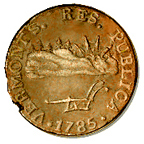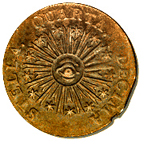
Vermont coppers
Encyclopedia


Vermont Republic
The term Vermont Republic has been used by later historians for the government of what became modern Vermont from 1777 to 1791. In July 1777 delegates from 28 towns met and declared independence from jurisdictions and land claims of British colonies in New Hampshire and New York. They also...
. The coins were first struck in 1785 and continued to be minted until Vermont's admission to the United States
United States
The United States of America is a federal constitutional republic comprising fifty states and a federal district...
in 1791 as the State of Vermont.
History
On June 10, 1785, the House of Representatives of the Freemen of Vermont met to select a committee of three to consider a request from Reuben Harmon, Jr. of RupertRupert, Vermont
Rupert is a town in Bennington County, Vermont, United States. The population was 704 at the 2000 census.-Geography:According to the United States Census Bureau, the town has a total area of 44.6 square miles , of which 44.6 square miles is land and 0.02% is water.-History:Many...
to mint copper coins for the new entity Vermont. Though Vermont's legislative branch at this period was unicameral, the Governor's Council, a part of the executive branch, acted as a sort of upper house. The Governor's Council appointed one of its members to join the committee studying the proposal. On June 15, 1785, the committee presented to the House of Representatives of the Freemen of Vermont their recommendation that Vermont grant Harmon "...the exclusive right of coining Copper within this State for the term of two years..." The approved language required the coins to have a minimum weight of one-third of an ounce troy weight (160 grains). The House approved the measure and sent the recommendation to the Governor's Council which concurred. On June 17, 1785, Harmon posted a required bond and began establishing his mint situated beside Hagar's Brook in Rupert.
1785 and 1786 landscape design
The same committee was retained to select a motto for the coins, and to oversee design. The design of the obverse, on the initial 1785 and 1786 coins, featured a sun rising above the Green Mountains and a plow in the foreground encircled by the inscription VERMONTS. RES. PUBLICA., which can be translated as the republic, or commonwealth, of Vermont. The design of the reverse of the coin is an almost wholesale appropriation of an earlier 1783 American coin called the Nova Constellatio (new constellation) design. It features a large single star emanating rays, with an eye within, it is surrounded by a wreath of 13 smaller stars, and they are encircled by the motto STELLA QUARTA DECIMAStella quarta decima
Stella quarta decima is a motto appearing on Vermont copper coinage struck in 1785 and 1786. The coins were issued during the period when Vermont was an independent state , sometimes referred to as the Vermont Republic.The motto appears on the reverse of the coin and encircles a corona of 13...
which translates as the 14th star. Subsequent issues altered the inscription on the obverse, variously using VERMONTIS. RES. PUBLICA. and VERMONTENSIUM. RES. PUBLICA.
1787 and 1788 bust design
In October of 1785, with new Vermont coppers in circulation, Harmon sought an extension of his exclusive two-year contract. An act, possibly written with Harmon, himself a former member of the House, extends the agreement eight years from July 1, 1787, and describes a dramatically different design. The obverse is to bear a bust, encircled with a new motto reading AUCTORITATE VERMONTENSIUM. which translates as by authority of Vermont. The reverse of the coin depicts a seated woman, and the inscription INDE ET LIB an abbreviation of independence and liberty. Sixteen variations of diesDie (manufacturing)
A die is a specialized tool used in manufacturing industries to cut or shape material using a press. Like molds, dies are generally customized to the item they are used to create...
on this second set of coins were made. The new design closely resembled the British halfpenny then in circulation in the American colonies. On that coin a bust of George III is encircled by the inscription GEORGIVS. III. REX. and the reverse with a seated female embodiment of Britain called Britannia
Britannia
Britannia is an ancient term for Great Britain, and also a female personification of the island. The name is Latin, and derives from the Greek form Prettanike or Brettaniai, which originally designated a collection of islands with individual names, including Albion or Great Britain. However, by the...
. A common explanation of the redesign of Vermont's coins, so close to the British half-pence model, has been made to make their circulation and exchange easier beyond Vermont's boundaries.
Symbolism
While the 1785 Act of the Vermont House describes the design of the bust and seated female figure design in detail, no notes of the period exist on the meaning of either the mottoes or imagery of Vermont's copper coinage. Twentieth century numismatists Kenneth Bressett, Tony Carlotto and Hillyer Ryder offer nearly identical explanations of the imagery and mottoes. The depiction of the sun rising above the Green Mountains is to indicate peace, and possibly the approval of Divine Providence. The plow may simply represent agriculture, a primary activity and industry of the young state, but might also allude to the story of CincinnatusCincinnatus
Lucius Quinctius Cincinnatus was an aristocrat and political figure of the Roman Republic, serving as consul in 460 BC and Roman dictator in 458 BC and 439 BC....
the ancient Roman citizen-farmer who left his plow in the field to serve Rome as consul
Consul
Consul was the highest elected office of the Roman Republic and an appointive office under the Empire. The title was also used in other city states and also revived in modern states, notably in the First French Republic...
, fight the encroachment of aristocracy, and later return to his field. The large single star, with the eye, on the 1785 and 1786 issues, is nearly identical in design to a widely available typographic device, or dingbat
Dingbat
A dingbat is an ornament, character or spacer used in typesetting, sometimes more formally known as a "printer's ornament" or "printer's character"....
, of the time called the Eye of Providence
Eye of Providence
The Eye of Providence is a symbol showing an eye often surrounded by rays of light or a glory and usually enclosed by a triangle...
, a Deist and Masonic
Freemasonry
Freemasonry is a fraternal organisation that arose from obscure origins in the late 16th to early 17th century. Freemasonry now exists in various forms all over the world, with a membership estimated at around six million, including approximately 150,000 under the jurisdictions of the Grand Lodge...
image suggestive of an all-seeing God. Here however the star may simply be Vermont itself, centered among the 13 stars likely used to suggest the existing 13 American states. The addition of the motto STELLA QUARTA DECIMA, the 14th star, is cited as a hope for eventual statehood. The seated female on the reverse side of the second design is modeled on the Britannia figure then on British half-pence. A similar seated female is found on the reverse of the coat of arms of Vermont
Coat of arms of Vermont
The coat of arms of Vermont is the official armorial bearings of the U.S. state of Vermont. Most of the elements found in the coat of arms originate in the Great Seal of Vermont designed by Ira Allen...
, and is described variously as Agriculture, or Ceres.

